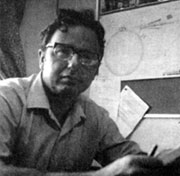Internal Target Head Reports Progress

Drasko Jovanovic
Experimentalists working in NAL's Internal Target Area completed taking data for four experiments, including the highly-successful U.S.-U.S.S.R. collaboration which opened its research in January of 1972 as the NAL machine first reached an energy of 100 BeV. According to Drasko Jovanovic, head of the Internal Target Group, completion of these experiments deserved special notice because they provided very early experimentation in an experimental area in the Main Accelerator before the external experimental areas were completed.
"At one point in NAL planning, such an area was thought to be potentially detrimental to the operation of the machine, primarily because of the possibility of excessive radioactivity," Jovanovic observed recently. "But we proved that the internal target was not only feasible but rather valuable. Experimenters were able to utilize the wide range of energies in the Main Accelerator and to benefit from study of the increases in energy before extraction. No small credit should be given to our Soviet collaborators who first applied the gas jet technique at Serpukhov in 1968."
Jovanovic's appointment as head of the Internal Target Group in NAL's Accelerator Division, came at a point when the Group was considering its next direction, having finished Phase I of its program. He brought in the knowledge he had gained since he became attached to the Accelerator Division development in mid-1972. For some months before that, while working for the Argonne National Laboratory, he lent his hand where needed at NAL. Tall, smiling, and energetic, Jovanovic was born in Belgrade, Yugoslavia, where his father headed the physics department at the University of Belgrade, and his mother was also in physics. The elder Jovanovic was an assistant to Marie Curie in Paris for 12 years. Drasko came to the University of Chicago on a UNESCO fellowship; he received his Ph.D. from Chicago. After crossing the U.S. thirty times between 1960 and 1962 as an experimenter at the Brookhaven National Laboratory in New York where he and his wife and family maintained residence, and at the same time serving as a faculty member at LaJolla Branch of the University of California, Drasko received a domestic ultimatum from Stanka. The solution - live near an accelerator.
Dr. Jovanovic's long acquaintance with accelerator laboratories gave him much expertise in the problems of radioactivity. Putting this to work immediately in the Accelerator Division, he designed "the Rover," a golf cart outfitted with detection equipment. A projecting wand on the Rover recorded data on radiation levels, enabling one person to monitor the 4-mile Main Ring quickly and efficiently.


